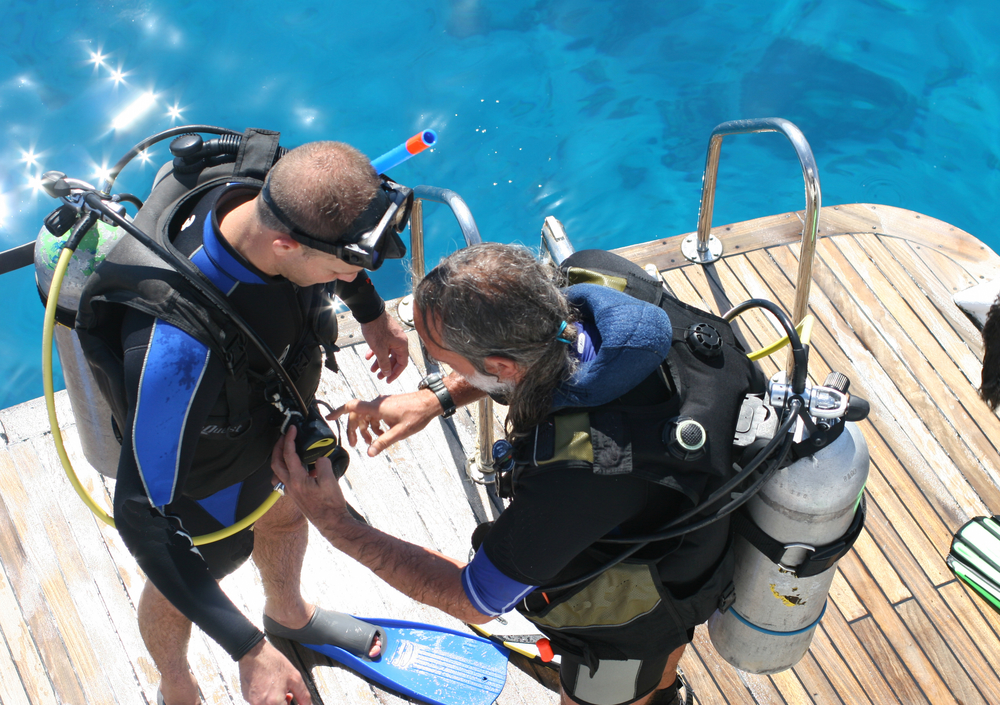Every dive should begin with BWRAF. Whether on a chaotic boat before the back roll or in a calm dive resort on a shore entry. You must do your BWRAF whatever situation, whomever you are buddied up with, wherever you are before dropping down to when it is impossible to do the bwraf.
Don’t feel like you are the “not cool” one for doing a buddy check before jumping in. After all, that certification card you have did not make you invincible….
Yes it can be messy on a boat, but remember why it was taught to you during your open water diver course. If you have forgotten let me remind you, remember the silly mnemonic of PADI,
Begin With Review And Friend
Well who can forget that?
BWARF is an easy-to-remember acronym that helps divers complete a thorough safety check before every dive. When it comes to scuba diving, safety is paramount, and preparation is key. That’s where the PADI BWRAF pre-dive safety check comes in—a simple and effective way to ensure your equipment and your buddy are ready before descending into the underwater world.
Here’s what BWARF really stands for:
- B: BCD (Buoyancy Control Device)
- W: Weights
- R: Releases
- A: Air
- F: Final Check
Let’s break it down step by step:

1. B – Buoyancy Control Device (BCD)
Check that your BCD is functioning properly.
- Inflate and deflate your BCD to ensure it’s working smoothly.
- Verify there are no leaks or damage to the hoses or bladder.
- Make sure your low-pressure inflator hose is securely attached to the BCD.
A properly functioning BCD is essential for maintaining buoyancy and control throughout the dive.
2. W – Weights
Ensure your weights are secure and properly adjusted.
- Check that your weight system is set up correctly, whether you’re using a weight belt or integrated weights.
- Make sure you can easily release your weights in an emergency.
- Confirm your buddy’s weights are also secure and easy to access.
Having the correct weight setup is crucial for achieving neutral buoyancy and avoiding unnecessary effort underwater.
3. R – Releases
Inspect and test all straps, buckles, and releases.
- Confirm that your BCD and tank straps are snug and secure.
- Practice locating and using all quick-release buckles on your buddy’s gear.
- Ensure your buddy knows how to operate your releases in case of emergency.
This step ensures your gear is properly secured and can be quickly removed if necessary.
4. A – Air
Confirm that your air supply is ready and sufficient.
- Check your air tank is full (at least 200 bar or 3000 psi, depending on local standards).
- Test your primary and alternate regulators by breathing through them and checking for any irregularities.
- Ensure your air is turned on fully, and your buddy does the same.
- Monitor your submersible pressure gauge (SPG) for proper functionality.
Reliable air supply is non-negotiable for a safe dive.
5. F – Final Check
Give yourself and your buddy one last thorough inspection.
- Look for anything out of place, such as tangled hoses or loose gear.
- Ensure all accessories (dive computer, mask, fins, etc.) are ready.
- Perform a buddy signal check to confirm underwater communication is understood.
The final check is your opportunity to catch anything you might have missed earlier.
Why BWRAF Matters
The BWARF check is more than just a checklist—it’s a mindset of preparedness and responsibility. By taking a few minutes to perform this check, you can:
- Prevent equipment-related issues during the dive.
- Build trust and communication with your dive buddy.
- Reduce stress, allowing you to enjoy the dive with confidence.
Memorizing BWRAF: Fun Mnemonics
Divers often create playful mnemonics to remember BWARF. Here are a few favorites:
- Babies With Rashes Are Fussy
- Barf Will Really Attract Fish
- Big Whales Really Are Friendly
and the most favorite
Burgers With Relish And Fries
Feel free to come up with your own to make it memorable and fun!
Conclusion
The PADI BWRAF pre-dive safety check is an invaluable habit for every diver, from beginners to seasoned professionals. By making this quick, easy process part of your dive routine, you’ll set the stage for safer, more enjoyable underwater adventures.
Next time you’re gearing up, remember: BWARF isn’t just a checklist—it’s your ticket to worry-free diving!

